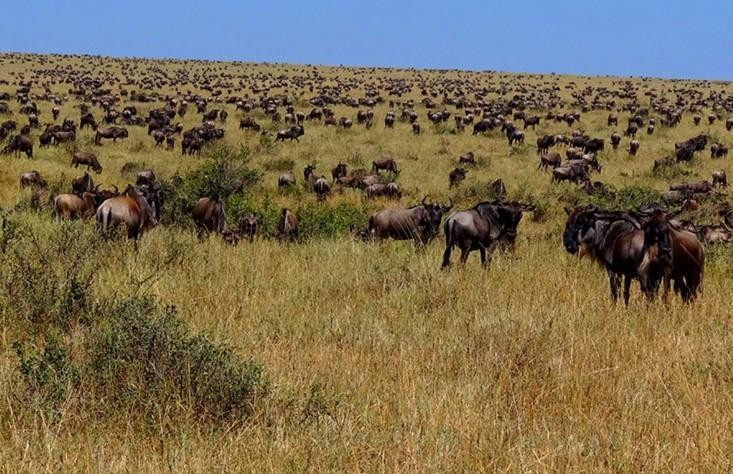Silverdreamsholidays explains how Blue and Black Wildebeests differ


Eastern and Southern parts of Africa boast of the numerous species of wildlife when compared to other section of the continent. Whether blue wildebeest or black wildebeest, the herbivores have added the beauty of the lands that they inhabit. It’s needless to point out that the animals many consider silly remain the top wildlife that attracts tourists.
Despite the spectacular behavioral exhibition in their natural habitat, many people find it hard to differentiate blue wildebeests and black wildebeests. At Silverdreamsholidays, we find it our duty to point the difference in several ways.
What’s in the name ‘Black’ wildebeest and ‘Blue’ wildebeest?
The knowledge of colors won’t add any meaningful value in differentiating the two animals that belong to the same genus. I know this will astonish you that the blue wildebeests have stripes on their dark grey color. Some blue wildebeests have bluish shins hence the name.
Black wildebeests, on the other hand, have colorful brown hair and their manes can range from cream to black color. Surely, whoever came up with the names based on the colors of the animals should be penalized for this confusion.
Blue Wildebeests and Black Wildebeests live in varied habitats
The animals share many features, but they’ve developed varied adaptations to live in a different environment within the vast continent of Africa. Blue wildebeests mainly live in grassland areas nearing the Savanna. Their ideal areas of survivals often have short plain grass neighboring acacia trees. The existing climate is neither dry nor wet, but good enough to allow the wildebeests to thrive.
The blue wildebeests are mainly found in East Africa’s countries with Kenya and Tanzania keen to share the mammals periodically in shifts. The Serengeti National Park in Tanzania and Maasai Mara Game Reserve host the spectacular creatures which cross the Mara River annually in a Migration that was once one of the ‘Seven Wonders of the World’.
Even though East Africa claims a substantial number of blue wildebeests, you can also find the intriguing animals in Zambia, Botswana, Namibia, and South Africa. However, in Malawi, the blue wildebeest went into extinction.
Black wildebeests inhabit the temperate zones of Southern part of the continent. In South Africa, you can get a glimpse of black wildebeest at Karoo shrubland where Khoi Khoi community lives. Massive human hunting in Namibia had depleted black wildebeests and led to their extinction, but the grazing animals were reintroduced in the country. Swaziland and Lesotho are other countries that now have the grazing animals after letting the wildebeest to extinct several decades ago.
Unequal weight and sizes in blue wildebeests and black wildebeest
At birth, both black and blue wildebeests weigh about 21 Kg, but the deference emerges during the growth with blue wildebeest claiming the supremacy in terms of the body mass. The blue wildebeest males are more giant and could weigh approximately 250 Kg while their female counterparts can weigh around 180 Kg.
If you use a 30cm-ruler for measurement, you’ll require five of them as a mature male blue wildebeest measures 150 cm from the ground to the shoulder. A female blue wildebeest has a height of about 135 cm.
An adult male black wildebeest attract an estimated mass of 180 Kg and a height of 120 cm. On the other side, the females’ shoulders measure around 108 cm while the weight is around 155 Kg.
Black wildebeests and blue wildebeests don’t have identical horns
From the look of horns, you can mistake a water buffalo for a big black wildebeest because the two animals’ horns appear identical. A black wildebeest has horns that curve to the front then downward, and finally turning up. A blue wildebeest’s horns first protrude sideways before curving downward and finally upward to the direction of the skull.
The description of the horns given above clearly indicates that black wildebeests have fearful and dangerous horns.
Both Black Wildebeests and Blue Wildebeests have highly nutritious milk
The curious society has prompted scientists to test the nutritious value of the milk coming from the wildebeests. The fact that wildebeests share a common family (Bovidae) with animals like goats, sheep, and cattle makes the milk of the wild animals have nearly equal nutritional content as domestic counterparts.
If you need energy, never go for the milk of black wildebeests. Indeed the black wildebeests do not need energy because they don’t migrate. Black wildebeests have lower fats and lactose when compared to the milk that comes from blue wildebeests. However, black wildebeests compensate for the lack of more energy in their milk with higher protein content when compared with their counterparts.
The lifestyles of Black Wildebeests and Blue Wildebeests
Even though black wildebeests and blue wildebeests only share the genus, the two can mate and produce hybrid offspring. Black wildebeests are considered lazy as they lead sedentary lives, but we cannot blame them because human fenced their territories thus restricting their movements. Also, almost 80% of wildebeests live in private areas that don’t encourage long-distance migration.
Blue wildebeests enjoy the freedom of moving from different countries at their will without acquiring passports. Unlike their compatriots, they lead nomadic lives that see them stay only temporarily in the parks.
Who has the numbers in terms of population
If it weren’t the conservation measures, black wildebeests would by now sealed their extinction paths just like the mythical dinosaurs. Namibia that currently leads in the population of black wildebeests had tasted life without the animals after the herbivores. The total number of black wildebeests is estimated to be in the region of 18,000 with Namibia claiming nearly 40% of the number.
Blue wildebeests are nearly reaching 2 million in numbers with nearly the entire population living in the wild as their second name suggests.
Final word on Blue Wildebeests and Black Wildebeests
Silverdreamsholidays is at the center stage of tourism activities and would wish to help you witness this year migration of blue wildebeests. The venue is at Mara River where you’ll have a clear view of the animals swapping countries and National Parks. The scenery is magnificent especially witnessing the wavy front in the migration suggesting tough decisions in the making in readiness to tackle predatory carnivores.
